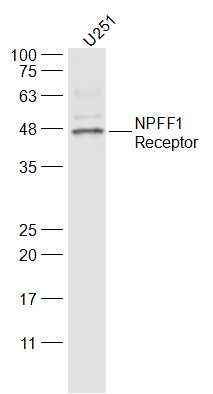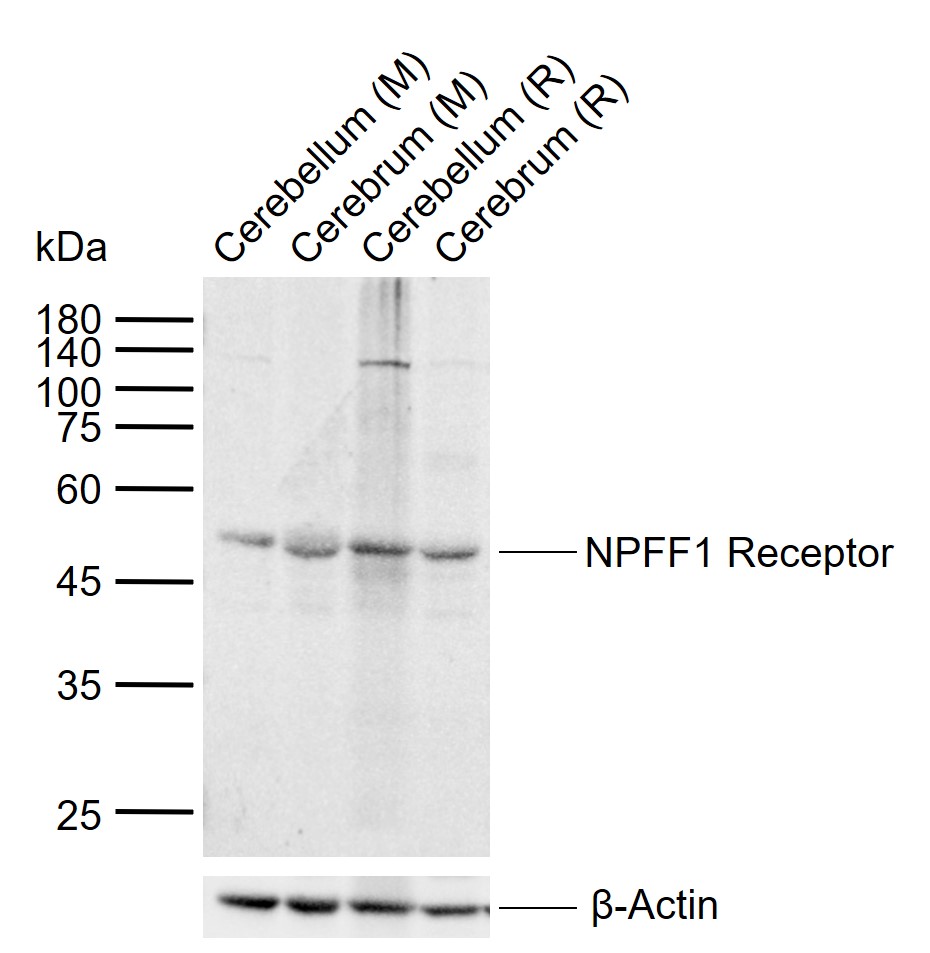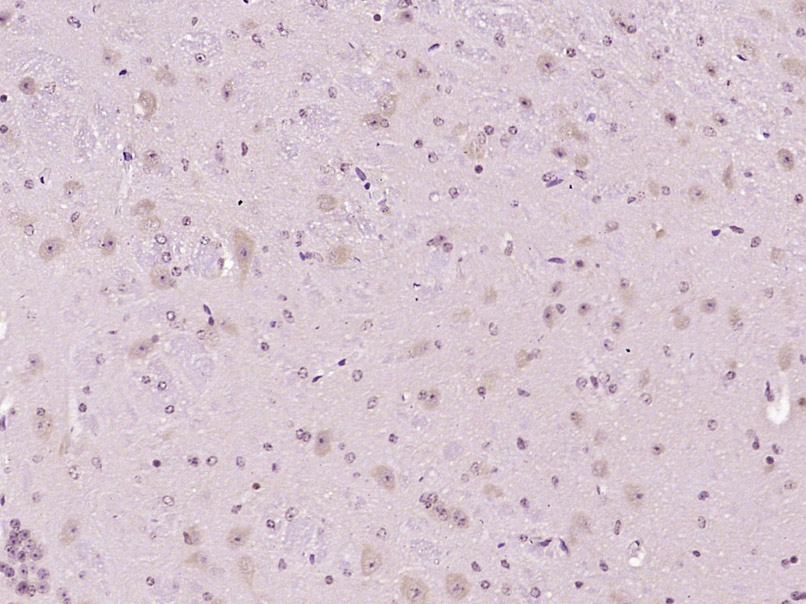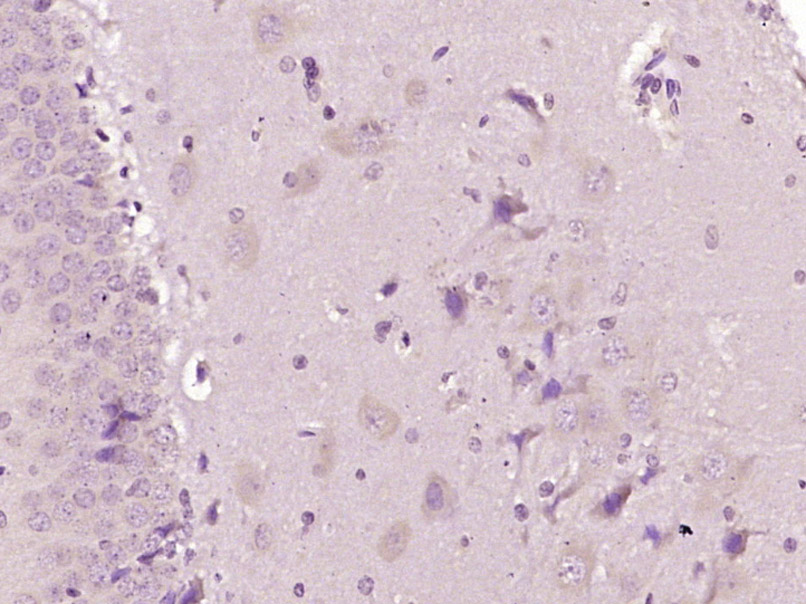
Rabbit Anti-NPFF1 Receptor antibody
NPFF1 Receptor; G Protein Coupled Receptor 147; G-protein coupled receptor 147; GPR147; Neuropeptide FF receptor 1; NPFF1; NPFF1_HUMAN; NPFF1R1; NPFFR1; RFamide related peptide receptor OT7T022; RFamide-related peptide receptor OT7T022.
View History [Clear]
Details
Product Name NPFF1 Receptor Chinese Name G protein-coupled receptor147抗体 Alias NPFF1 Receptor; G Protein Coupled Receptor 147; G-protein coupled receptor 147; GPR147; Neuropeptide FF receptor 1; NPFF1; NPFF1_HUMAN; NPFF1R1; NPFFR1; RFamide related peptide receptor OT7T022; RFamide-related peptide receptor OT7T022. literatures Research Area Cell biology Neurobiology Signal transduction The cell membrane受体 G protein-coupled receptor G protein signal Immunogen Species Rabbit Clonality Polyclonal React Species Human, Mouse, Rat, (predicted: Dog, Pig, Cow, Horse, Rabbit, Sheep, ) Applications WB=1:500-2000 ELISA=1:5000-10000 IHC-P=1:100-500 IHC-F=1:100-500 ICC=1:100-500 IF=1:100-500 (Paraffin sections need antigen repair)
not yet tested in other applications.
optimal dilutions/concentrations should be determined by the end user.Theoretical molecular weight 48kDa Cellular localization The cell membrane Form Liquid Concentration 1mg/ml immunogen KLH conjugated synthetic peptide derived from human GPR147/NPFF1 Receptor: 151-260/430 <Extracellular> Lsotype IgG Purification affinity purified by Protein A Buffer Solution 0.01M TBS(pH7.4) with 1% BSA, 0.03% Proclin300 and 50% Glycerol. Storage Shipped at 4℃. Store at -20 °C for one year. Avoid repeated freeze/thaw cycles. Attention This product as supplied is intended for research use only, not for use in human, therapeutic or diagnostic applications. PubMed PubMed Product Detail Neuropeptide FF 1 Receptor (NPFF1 or hFF1) and Neuropeptide FF 2 Receptor (NPFF2) belong to the G protein-coupled receptor 1 family. Both NPFF1 and NPFF2 are integral membrane proteins that act as receptors for NPAF (A-18- F-amide) and NPFF (F-8-F-amide) neuropeptides. Both NPFF proteins may be activated by synthetic or naturally occurring FMRF-amide-like ligands. The receptors are mediated by association with G proteins that activate a phosphatidylinositol-calcium second messenger system. NPFF1 Receptors is highly expressed in the human hypothalamus and amygdala, indicating a possible role for NPFF1 in central autonomic and neuroendocrine control in the human brain. Based in part on NPFF2 Receptor expression in diencephalon and superficial layers of the spinal cord, NPFF2 Receptor is thought to be involved in the modulation of sensory input and opioid analgesia.
Function:
Receptor for NPAF (A-18-F-amide) and NPFF (F-8-F-amide) neuropeptides, also known as morphine-modulating peptides. Can also be activated by a variety of naturally occurring or synthetic FMRF-amide like ligands. This receptor mediates its action by association with G proteins that activate a phosphatidylinositol-calcium second messenger system.
Subcellular Location:
Cell membrane.
Similarity:
Belongs to the G-protein coupled receptor 1 family.
SWISS:
Q9GZQ6
Gene ID:
64106
Database links:Entrez Gene: 64106 Human
Omim: 607448 Human
SwissProt: Q9GZQ6 Human
Unigene: 302026 Human
Unigene: 64483 Rat
Product Picture
U251(Human) Cell Lysate at 30 ug
Primary: Anti-NPFF1 Receptor (SL12018R) at 1/300 dilution
Secondary: IRDye800CW Goat Anti-Rabbit IgG at 1/20000 dilution
Predicted band size: 48 kD
Observed band size: 48 kD
Sample:
Lane 1: Mouse Cerebellum tissue lysates
Lane 2: Mouse Cerebrum tissue lysates
Lane 3: Rat Cerebellum tissue lysates
Lane 4: Rat Cerebrum tissue lysates
Primary: Anti-NPFF1 Receptor (SL12018R) at 1/1000 dilution
Secondary: IRDye800CW Goat Anti-Rabbit IgG at 1/20000 dilution
Predicted band size: 48 kDa
Observed band size: 48 kDa
Paraformaldehyde-fixed, paraffin embedded (Mouse brain); Antigen retrieval by boiling in sodium citrate buffer (pH6.0) for 15min; Block endogenous peroxidase by 3% hydrogen peroxide for 20 minutes; Blocking buffer (normal goat serum) at 37°C for 30min; Antibody incubation with (NPFF1 Receptor) Polyclonal Antibody, Unconjugated (SL12018R) at 1:400 overnight at 4°C, followed by operating according to SP Kit(Rabbit) (sp-0023) instructionsand DAB staining.Paraformaldehyde-fixed, paraffin embedded (Rat brain); Antigen retrieval by boiling in sodium citrate buffer (pH6.0) for 15min; Block endogenous peroxidase by 3% hydrogen peroxide for 20 minutes; Blocking buffer (normal goat serum) at 37°C for 30min; Antibody incubation with (NPFF1 Receptor) Polyclonal Antibody, Unconjugated (SL12018R) at 1:400 overnight at 4°C, followed by operating according to SP Kit(Rabbit) (sp-0023) instructionsand DAB staining.
Bought notes(bought amounts latest0)
No one bought this product
User Comment(Total0User Comment Num)
- No comment






 +86 571 56623320
+86 571 56623320
 +86 18668110335
+86 18668110335

